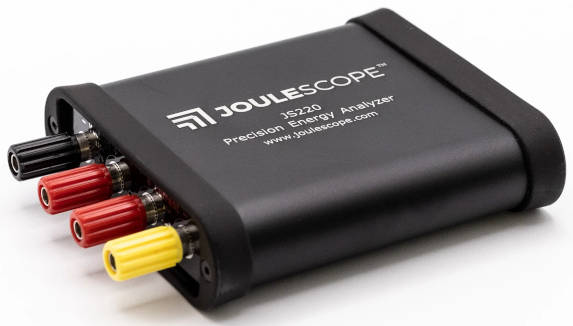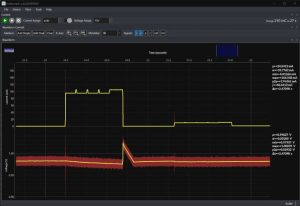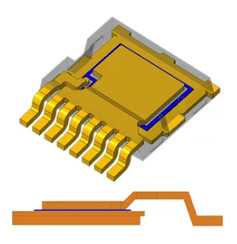
Called JS220, it has a huge dynamic range: ±3A max (10A peak) with 500pA resolution over six 16bit auto-ranges – equivalent to 34bit – which allows he measurement of both active and sleep power.
It has a bandwidth of 300kHz backed by a 2Msample/s conversion – simultaneously on current and voltage – max voltage is ±15V.
To reduce measurement burden, the maximum drop across the current measurement terminals is 20mV (internal shunts range from 10mΩ to 1.111kΩ) and the voltage input has an impedance of around 1GΩ.
“Other equipment, including standard multimeters, have a much larger burden voltage that can
cause the target device to behave unusually,” according to Jetperch, and “most [voltage] test instruments add a known resistance, often 1MΩ or 10MΩ”.
There are two voltage auto-ranges, giving a 107dB dynamic range.

In the earlier JS110, V+ and I+ on the inputs were internally linked. For the JS220, they are not and the current sense can float anywhere within the ±15V maximum of the voltage input. “The JS220 is specifically designed to enable more accurate, four-wire Kelvin-connection measurements,” according to the company.
On the subject of floating, the USB input is galvanically isolated from the I and V inputs – although this is not safety isolation – it is for measurement purposes, and up to ±48V between USB ground and any of the four measuerment inputs.
All 2Msample/s are sent over to the host PC for display and recording (circular buffer depending on PC memory).

There are two main display modes: oscilloscope (above) and multi-meter (right).
The software applies per-device factory calibration values as it converts the readings into displayed values.
Other connections include four general-purpose inputs and two general-purpose outputs, plus a BNC connector for trigger (input or output).
These auxiliary connections are on the USB (PC) side of the isolation barrier, and therefore will sometimes need their own external isolation if they are to be connected to the measurement side.
The banana jack faceplate at the measurement end can be removed and replaced with faceplates with: USB connectors, BNC connectors or banana jacks mimicking the earlier JS110 face plate. The faceplate design is open-sourced on GitHub to allow users to make their own.
 To put the instrument though its paces is an evaluation board (left) that pushes straight into the measurement end through four 4mm pins. Rather than being dumb, the eval board includes a Raspberry Pi RP2040 IC which runs pre-configured load patterns, and can be programmed with Micropython to produce others.
To put the instrument though its paces is an evaluation board (left) that pushes straight into the measurement end through four 4mm pins. Rather than being dumb, the eval board includes a Raspberry Pi RP2040 IC which runs pre-configured load patterns, and can be programmed with Micropython to produce others.
Jetperch is based in Maryland
JS220 compared with original JS110
| Feature | JS220 | JS110 |
|---|---|---|
| Bandwidth (kHz) | 300 | 250 |
| ADC bits | 16 | 14 |
| Smooth range switching | ✓ | – |
| General Purpose Inputs | 4 | 2 |
| General Purpose Outputs | 2 | 2 |
| Trigger In/Out | 1 | 0 |
| Soft Fuse | ✓ | – |
| Swappable front panel | ✓ | ✓ |
| Open-source C driver | ✓ | – |
| Open-source python driver | ✓ | ✓ |
| Python scripting | ✓ | ✓ |
| Host OS support | Windows macOS Linux |
Windows macOS Linux |
Current
| Feature | JS220 | JS110 |
| Bandwidth | 300kHz | 250 |
| Dynamic Range | 208dB | 196 |
| sampling rate | 2MHz | 2000 |
| ADC | SAR | SAR |
| ADC bit depth | 16bit | 14 |
| Effective number of bits | 15.1 | 12 |
| Output sample rate | 1Ms/s max* | 2 |
| Sustained maximum | ±3A | -1.5 to 3 |
| Maximum pulse | ±10A | -1.5 to 10 |
| Typical resolution | 0.5nA | 1.5 |
| Measurement burden | 20mV max | 20 |
| Shunt switching time | 1.0µs max | 1.2 |
| Range switch settle time | 0.0µs max | 5.0 |
Voltage
| Feature | JS220 | JS110 |
|---|---|---|
| Bandwidth | 300kHz | 250 |
| Dynamic Range | 107dB | 93 |
| ADC sampling rate | 2000kHz | 2000 |
| ADC type | SAR | SAR |
| ADC bit depth | 16bit | 14 |
| ADC effective number of bits | 15.1 | 12 |
| Output sample rate (max) | 1Ms/s* | 2 |
| Maximum measurement | ±15V | -1 to +15 |
*website figure, being checked







